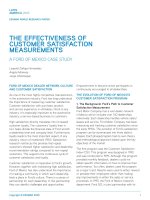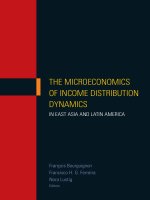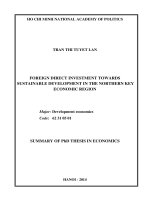world bank the effectiveness of promotion agencies at attracting foreign direct investment phần 6 doc
Bạn đang xem bản rút gọn của tài liệu. Xem và tải ngay bản đầy đủ của tài liệu tại đây (103.18 KB, 12 trang )
50 / The Effectiveness of Promotion Agencies
They also indicate that including the private sector contributes to
broaden the platform and help to achieve a consensus in the
agency’s effort to market the country abroad. Yet they should
not be used to overestimate the role of the IPA. The reporting
mechanism to the president or the prime minister may reflect the
overall commitment of the government toward reforms. Within
that context, the positive correlations reported above, although
indicative, would capture this global trend in the government’s
effort rather than the agency’s own performance.
Some IPA characteristics do not seem to influence the
agency’s performance. The agency’s mandate, staff qualification,
and number of overseas offices have no significant association
with FDI flows. It is possible that these characteristics do not
matter. Another possibility is that our survey has too little varia-
tion in these factors to identify their eventual impact on the
effectiveness of IPAs.
The lack of influence from the number of mandates is some-
what surprising because of the belief that agencies focusing
exclusively on investment promotion should be more effective
than those dealing with several activities simultaneously.
Although export promotion and investment promotion are
indeed related,
36
these two activities are in reality quite different.
They require different skills, and they involve contacts with dif-
ferent kinds of managers within foreign firms. Investment pro-
motion is very similar to the business task of selling major plant
and equipment. Not only will the decision affect the costs of the
firm and its access to particular markets, but it also may have
broad strategic implications, such as generating moves from
competitors or even affecting the firm’s political relations at
home. The decisions to make such investments require the com-
mitment of very high levels of management—and convincing
management demands personal selling skills as well as the provi-
sion of various kinds of services. In contrast, export promotion is
very similar to the business tasks of retail sales or sales of materi-
als. They are likely to involve repeated smaller transactions,
Key Internal Characteristics of Investment Promotion Agencies and Their Roles / 51
rather than one large-scale transaction, as in the case of a direct
investment. Because the commitment is less and the decision is
reversible, the amount of research done by the “buyer” is likely
to be less than that done for a major investment decision. The
different characteristics of exports and investments suggest that
the two functions should be separated in two organizations.
We did not find any significant relationship between the man-
date and the IPA effectiveness, suggesting that the argument
might be more subtle than what is briefly summarized above.
Although investment and export promotion do differ, they can
be carried out effectively by one agency if the agency’s structure
and organization distinguish clearly between these two func-
tions. The success of a few promotion agencies has shown that
there are sufficient similarities and common goals that the two
organizations should cooperate closely. Each is likely to be able
to make use of material prepared by the other, for example.
Cooperation might even extend to sharing of space, to save rent.
The two opposite effects might explain the absence of significant
empirical results.
52 / The Effectiveness of Promotion Agencies
Technical Appendix
The influence of the main IPA characteristics on the FDI flows
was tested using the same approach as described in chapter 4. We
used the basic FDI equation defined in the technical appendix in
chapter 2 to which we add, as an explanatory variable, each IPA
characteristic.
FDI = b
0
+ b
1
PE + b
2
EV + b
3
IPA
FDI is defined as the flows of foreign direct investment, PE as
the promotion effort, EV as a set of external variables, and IPA
as a set of IPA characteristics. All these variables have been
described in the main text.
The methodology was twofold. First, we used dummy variables
and, second, an interactive term multiplied to the IPA budget.
The first approach captures the possible effect of the IPA charac-
teristics on the FDI flows independently of the promotion effort.
The second approach assumes a linear relationship between the
IPA budget and the IPA characteristics. These two approaches
have been detailed in the technical appendix to chapter 4.
The main empirical findings are summarized in table 5.1.
Key Internal Characteristics of Investment Promotion Agencies and Their Roles / 53
Table 5.1 The Influence of IPA Characteristics on FDI Inflows
Dependant variable/explanatory variable
a
FDI FDI FDI
Public agency dummy –0.79
(–2.43)
Number of private representatives 0.052
in the IPA board
b
(2.72)
Prime minister/president dummy 0.53
(1.80)
IPA budget 0.21 0.22 0.25
(1.95) (2.01) (2.29)
Observations 56 36 55
AdjR
2
0.71 0.72 0.68
Note: t statistics in parentheses.
a.We omit reporting the results associated with the constant term, GNI per capita, and
the Heritage Foundation Index that were also included in the above regressions.
b. The number of representatives ranges from one to the maximum registered in our
survey.
54
6
6
Conclusion and Policy
Recommendations
Our research has been the first empirical study on the effective-
ness of investment promotion agencies in attracting FDI. Such
agencies exist in almost all the countries around the world, but
there has been no global attempt to determine whether they have
been able to significantly influence the investor’s decision to
locate in one country rather than another.
Although our empirical approach contains several limitations,
it shows that promotion is unambiguously associated with
greater FDI flows, on top of the influence of factors such as the
country’s investment climate and market size. The first conclu-
sion is, therefore, that establishing a promotion agency could
bring some benefits in most countries around the world.
Furthermore, the agency’s budget needs to be big enough to
carry on basic promotion activities. Presumably, promotion
activities have large fixed costs, such as taking care of potential
investors, traveling, and providing promotional materials.
Agencies with budgets that are too small are basically unable to
attract the attention of most investors. Our review of the recent
international experience indicates that this financial commitment
Conclusion and Policy Recommendations / 55
has to come principally from the government, which remains the
main source of financing.
The effectiveness of IPAs needs to be qualified: it is highly
dependent on the quality of the investment climate and the level
of development of the country in which the agency operates.
Countries with a relatively poor investment climate or low
income per capita should focus on improving these factors rather
than spending on promotion, especially if the IPA budget needs
to reach a certain level, as argued earlier. The argument is that
improving the investment climate will not only contribute direct-
ly to attracting more investment, it will also enhance the impact
of promotion and, in turn, lead to additional investment.
The type of activities that IPAs carry out also has an influence
on their effectiveness in attracting FDI. We find that on average
IPAs should devote more resources to policy advocacy activities
that contribute to the improvement of the investment climate
and thus generate additional investments. These activities are not
only beneficial for FDI but also for domestic investment. In con-
trast, investment generation or targeting, which has been privi-
leged at least in terms of budgetary allocation by most agencies,
appears as the function the least associated with cross-country
variations in FDI flows. Moreover, this function is expensive and
risky, especially in countries with poor investment climates.
Last but not least, a few IPA characteristics influence their
capacity to attract FDI. Countries where the agencies have estab-
lished reporting mechanisms to the highest level of policymakers
(for example, the president or the prime minister) and have ben-
efited from the support of the private sector have been systemat-
ically associated with more FDI. Such institutional links strength-
en the government’s commitment and reinforce the agency’s
credibility in the eyes of the business community.
56
Statistical Appendix
T
he Foreign Investment Advisory Service (FIAS), with the sup-
port of the Multilateral Investment Guarantee Agency
(MIGA) and the World Association of Investment Promotion
Agencies (WAIPA), conducted a survey of more than 100
investment promotion agencies around the world.
The questionnaire was developed with the active participation
of former and current IPA managers and international experts.
Pretesting was carried out on five IPAs in January 2002. The
final questionnaire included 192 questions.
The survey was designed to gather quantitative information
on the following five categories:
1. IPA institutional features (10 questions)
2. Mandate and responsibilities (16 questions)
3. Financial and human resources (37 questions)
4. Functions and activities (92 questions)
5. Performance indicators (34 questions).
Between February and May 2002, the survey instrument was
sent via email or fax to 114 agencies around the world, in both
developing and industrial countries. To ensure some homogeneity
Statistical Appendix / 57
in the database, the sample included only national IPAs. We were
able to collect responses from 75 agencies, yielding an overall
response rate of 66 percent. The rate was even higher in Latin
America and in Eastern and Central Europe, where it reached 86
percent and 71 percent, respectively. The number of responses was
also relatively well distributed among low-income, middle-income,
and high-income countries, giving us a well-diversified sample in
terms of economic development and investment climates.
The responses to a selected set of questions are summarized in
a series of figures and tables. For confidentiality purposes, the
responses are reported for income groups rather than for indi-
vidual countries. We used the World Bank’s classification to
define low-, lower-middle-, upper-middle-, and high-income
countries.
Institutional Features
Figure 1 Age of Agency
Figure 2 Mode of Creation
Figure 3 Institutional Forms
Figure 4 Reporting Mechanism
Mandate and Responsibilities
Figure 5 Export and Investment Promotion
Figure 6 Prime Responsibility in Granting Incentives,
Licenses, or Both
Figure 7 Investment Promotion and Privatization
Financial and Human Resources
Figure 8 Annual Budget per Income Group
Figure 9 Budget Allocation per Agency Function
58 / The Effectiveness of Promotion Agencies
Figure 10 Number of Professionals Employed in FDI
Promotion
Figure 11 Staff Qualification
Function and Activities
Figure 12 Average Web Hits and Inquiries per Year
Figure 13 Advertisement in Domestic and Foreign Media
per Year
Table 1 Investment Generation Activities (Average per
Agency)
Table 2 Investor Services (Average per Agency)
Figure 14 Policy Advocacy Activities
Institutional Features
Figure 1. Age of Agency
8
11
13
9
4
6
13
9
0
5
10
15
20
25
30
High income Upper-middle
income
Lower-middle
income
Low income
Years
Average Median
Statistical Appendix / 59
Figure 2. Mode of Creation
27%
76%
63%
42%
47%
24%
29%
21%
27%
8%
37%
0%
20%
40%
60%
80%
100%
120%
High income Upper-middle
income
Lower-middle
income
Low income
T
otal agencies
Law Decree Other regulations
*
Figure 3. Institutional Forms
0
10
20
30
40
50
60
70
High
income
Upper-middle
income
Lower-middle
income
Low income
T
otal agencies
Unit of a ministry
Autonomous public
Joint public/private Private
Mandate and Responsibilities
Figure 5. Export and Investment Promotion (% of Total Agencies per
Income Group)
60 / The Effectiveness of Promotion Agencies
Figure 4. Reporting Mechanism
20%
35%
33%
16%
27%
29%
4%
16%
40%
35%
58%
42%
0%
10%
20%
30%
40%
50%
60%
70%
80%
90%
100%
High
income
Upper-middle
income
Lower-middle
income
Low income
Total agencies
Ministry only Board only Board and ministry
13%
38%
43%
20%
0
5
10
15
20
25
30
35
40
45
50
High
income
Upper-middle
income
Lower-middle
income
Low income
Percent of agencies
Statistical Appendix / 61
Figure 6. Prime Responsibility in Granting Investment Incentives,
Licenses,or Both (% of Total Agencies per Income Group)
40%
38%
30%
55%
0
10
20
30
40
50
60
High
income
Upper-middle
income
Lower-middle
income
Low income
Percent of agencies
Figure 7. Investment Promotion and Privatization (% of Total Agencies
per Income Group)
19%
22%
15%
0
5
10
15
20
25
Upper-middle
income
Lower-middle
income
Low income
Percent of agencies
Note: Agencies in high-income countries did not report having any responsibility for
privatization.









